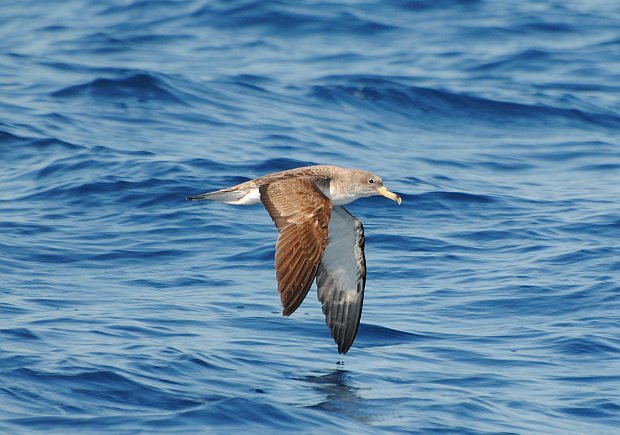
I teach human evolution, and at some point I use a chart showing reversals in the Earth’s magnetic field, which in turn relates to how we date some ancient sites. At some point, perhaps in the middle of class, perhaps after class, perhaps in an email I receive later, this question gets asked:
“How do migratory birds not get lost when the Earth’s magnetic field reverses?”
For years, my answer was this:
“Well, maybe a lot of them do, nobody said life was fair. But also, birds certainly use multiple cues to get around. The positions of sun and moon don’t change, they can still see features of the landscape and we know some bird species have mental maps of rivers, mountains, and coast lines. So maybe that.”
Now, I have a new answer:
“There’s something about your question that doesn’t smell right!”
![]() A newly published study of Cory’s Shearwaters demonstrates to a high degree of certainty that pelagic sea birds, at least this species, use mental maps of odor to find their way around. In an elaborate experiment, adult Sheawaters were take away from their nests during nesting season and given a series of treatments, and released hundreds of kilometers away. Some birds were simply released, some had their “magnetic sense” (assuming they have one) scrambled, and some had their sense of smell scrambled. The details are complicated but the article is OpenAccess, so I’ll leave it to you, dear reader, to examine the paper to the degree you like. Here, I’m only interested in the conclusion.
A newly published study of Cory’s Shearwaters demonstrates to a high degree of certainty that pelagic sea birds, at least this species, use mental maps of odor to find their way around. In an elaborate experiment, adult Sheawaters were take away from their nests during nesting season and given a series of treatments, and released hundreds of kilometers away. Some birds were simply released, some had their “magnetic sense” (assuming they have one) scrambled, and some had their sense of smell scrambled. The details are complicated but the article is OpenAccess, so I’ll leave it to you, dear reader, to examine the paper to the degree you like. Here, I’m only interested in the conclusion.
And the conclusion is this: Cory’s Sheawaters with mixed up magnetics find their way home, but birds with negated noses don’t easily do so. But there is a more important and larger scale conclusion to this work as well. We already knew that some birds (including tubenoses) can easily track a scent trail upstream to their smelly nest sites. Indeed, one wonders if the awful smell of nesting areas of these pelagic is all pat of an elaborate avian plan. But the Shearwaters in this study were not tracing the smell of their home island, and in fact, could not have done so given the pattern of release. Rather, birds who had unimpeded olfactory sense simply knew their way around the featureless seascape, while those with no nose wandered haplessly about until they either more or less randomly found their way home, spotted a visual clue that alerted (some of them) as to where they were located, or until their olfactory function returned. (Some never did return home.)
So, my answer to the students wondering about magnetic reversals is similar but altered: Apparently some birds have a reasonably detailed map of the world in which they live based on what it smells like, as well as what it looks like, and the role of magnetics in navigation may be very much over-estimated by we silly humans.
And here is the author’s summary:
Pelagic birds, which wander in the open sea most of the year and often nest on small remote oceanic islands, are able to pinpoint their breeding colony even within an apparently featureless environment, such as the open ocean. The mechanisms underlying their surprising navigational performance are still unknown. In order to investigate the nature of the cues exploited for oceanic navigation, Cory’s shearwaters, Calonectris borealis, nesting in the Azores were displaced and released in open ocean at about 800 km from their colony, after being subjected to sensory manipulation. While magnetically disturbed shearwaters showed unaltered navigational performance and behaved similarly to unmanipulated control birds, the shearwaters deprived of their sense of smell were dramatically impaired in orientation and homing. Our data show that seabirds use olfactory cues not only to find their food but also to navigate over vast distances in the ocean.
_________
Anna Gagliardo1, Joël Bried, Paolo Lambardi, Paolo Luschi1, Martin Wikelski, & Francesco Bonadonna4 (2013). Oceanic navigation in Cory’s shearwaters: evidence for a crucial role of olfactory cues for homing after displacement Journal of Experimental Biology, 216 (15) DOI: 10.1242/jeb.085738
The photograph of Cory’s Shearwater is from this blog post.













In order to establish this mental map of odor, I presume they would need at least one more navigation system that allows them to exactly know where one odor area is located in relation to another odor during their process of “mapping” the sea?
Jochen, that sounds a bit like a chicken-and-egg problem. Where does the bird get its first set of information to calibrate the second one?
But yes, there may be, and I suspect probably are, multiple systems at work, including visual. Also, the odor map may be quite fluid and combined with visual cues work effectively.